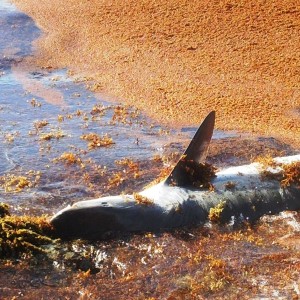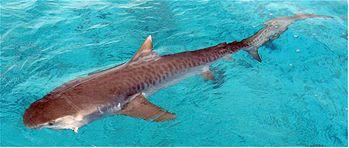In Shark Week, Shark CSI in the Grenadines
Clifton, August 15, 2014 – SusGren reports back on efforts to determine the cause of death of the tiger shark that was recently found floating dead in the Grenadines.
Caribbean news. Less than two weeks ago we reported on the unusual occurrence of a dead tiger shark that washed ashore amongst large quantities of seaweed in the Grenadines.
“There has been a lot of interest in the tiger shark, and we’ve now consulted with a number of Caribbean shark experts to try and determine possible causes of death.” said Ms. Orisha Joseph, Communications Officer for the non-profit organisation SusGren. “Given the great public interest in this shark, we’re pleased to share what we’ve learned.”
Firstly, it’s important to stress that without a necropsy and further studies it really is impossible to determine an exact cause of death. Ms. Joseph commented: “It’s very unusual for a dead shark to wash ashore, because unlike other fish, sharks normally sink. So scientists have also been interested in this unusual occurrence.”
There are a number of possible causes of death. One possibility is that the shark died after previously being caught in fishing gear. Tiger sharks are highly susceptible to fishing pressure and as a result they’re officially considered by scientists as ‘near threatened’ with extinction. But in this case, there were no obvious signs of fishing hooks or lines, nor visible damage to the shark from entanglement in a fishing net.
Tiger sharks are known to scavenge and will eat litter that they might find in the sea. So marine litter like plastics or other foreign items could have become clogged in the shark’s digestive organs. But fishers who opened the shark reported that there were no such stomach contents. Nor were any internal anomalies reported by the fishers.
“Nonetheless, this is a good reminder to dispose of plastic bottles, plastic bags and all our rubbish properly so that it doesn’t end up as litter in the sea and cause harm to vulnerable sea creatures”, commented Ms. Joseph.
The shark’s stomach was found to contain just two small fish. Of note, there were no turtles in the stomach, nor any remains of turtles. And there were definitely no human remains in the stomach.
Based on photos, one shark researcher felt the shark looked particularly skinny and could have been underweight, which is a potentially significant finding.
“Sharks are apex predators and they’re important indicator species – this means that the condition of the shark can tell us about the availability of its prey, which in turn gives us information about impacts of over-fishing in its territory and perhaps even insight into effects of climate change on currents and fish movements,” explained Ms. Joseph.
Unfortunately before the shark could be properly measured, it was cut up and disposed of. “That’s a shame because exact length measurements and weight would have enabled us to compare with known information about shark size, age and condition. This underlines how important it is with such occurrences to give local scientists the chance to take necessary measurements and observations,” added Mr. Martin Barriteau, Executive Director of SusGren.
 “Seaweed was found in the shark’s gills, but it’s hard to know for sure whether that caused its death or if it occurred in the process of the shark washing up in the seaweed,” said Mr. Barriteau.
“Seaweed was found in the shark’s gills, but it’s hard to know for sure whether that caused its death or if it occurred in the process of the shark washing up in the seaweed,” said Mr. Barriteau.
Tiger sharks can be found in coastal areas and are sometimes seen at the surface of the water. They’re solitary hunters that feed primarily at night when they come further inshore and closer to the surface. Tiger sharks have been observed scavenging among patches of seaweed in The Bahamas.
“It seems a reasonable hypothesis that this shark was scavenging within the thick seaweed currently affecting the Grenadines and became trapped closer to shore where the seaweed was dense and compacted,” suggests Mr. Barriteau.
“Without more data it’s impossible to determine the cause of death. What we have established is that the tiger shark was a female, and based on its estimated length of 11 feet we believe it was a mature female, so it was at least 4 to 6 years old. Tiger sharks give birth to live young and are pregnant for 14-16 months but they only bear young once every three years. So it’s perhaps not surprising that this shark was not found to be carrying any pups,” he explained.
Ms. Joseph commented: “Compared with other sea creatures, there’s relatively little known about sharks. Myths abound, but the reality is that they are rare creatures and this was an exceptional occurrence.”
Members of the public are asked to report any sightings of dead or injured marine life, especially sharks, manta rays, sea turtles, whales and dolphins, and seabirds to the Fisheries Division or to SusGren.
For more information please contact Sustainable Grenadines Inc., Clifton, Union Island, St. Vincent and the Grenadines. Tel/Fax: # (784) 485 – 8779. e-mail: [email protected]



